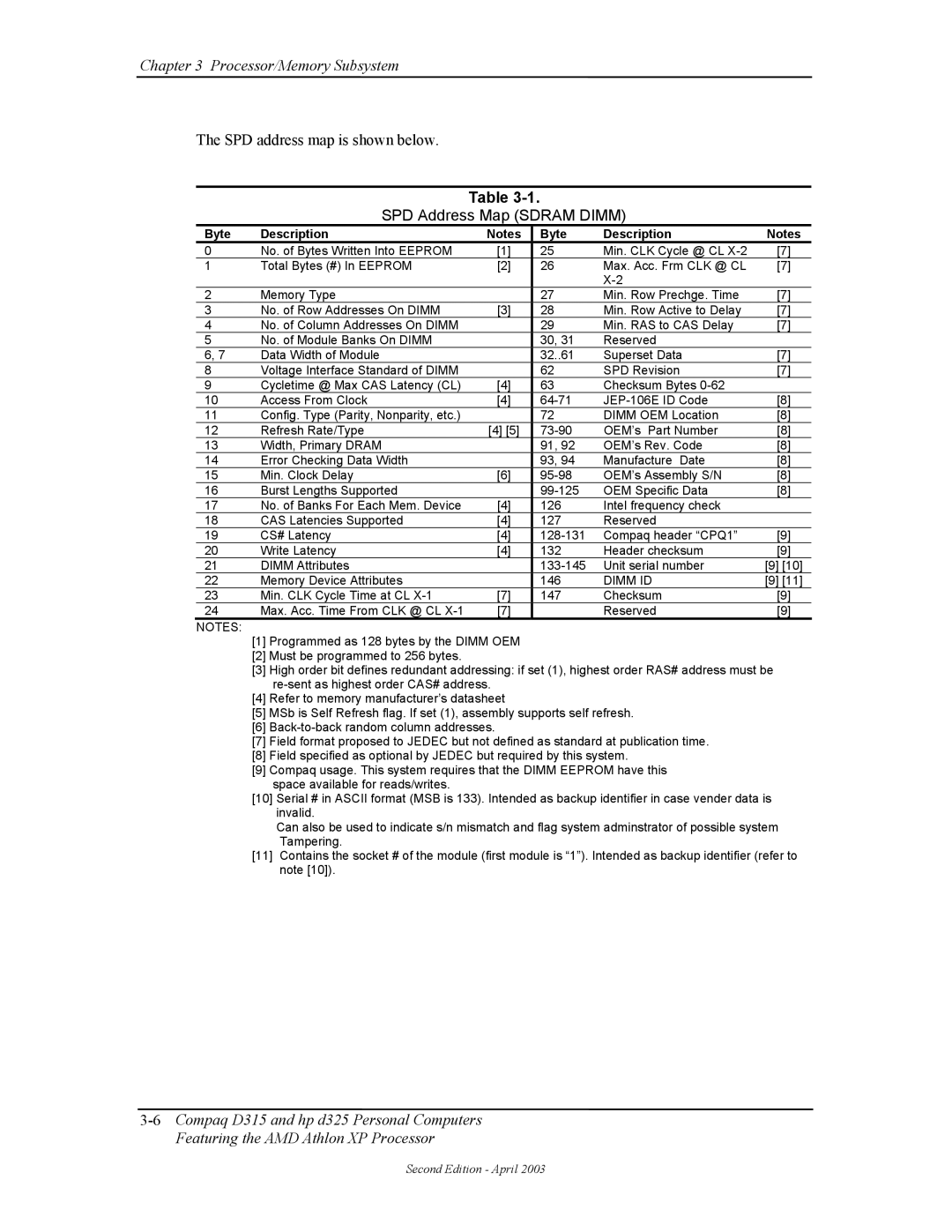
Chapter 3 Processor/Memory Subsystem
The SPD address map is shown below.
Table
Table
SPD Address Map (SDRAM DIMM)
Byte | Description | Notes | Byte | Description | Notes |
0 | No. of Bytes Written Into EEPROM | [1] | 25 | Min. CLK Cycle @ CL | [7] |
1 | Total Bytes (#) In EEPROM | [2] | 26 | Max. Acc. Frm CLK @ CL | [7] |
|
|
|
|
| |
2 | Memory Type |
| 27 | Min. Row Prechge. Time | [7] |
3 | No. of Row Addresses On DIMM | [3] | 28 | Min. Row Active to Delay | [7] |
4 | No. of Column Addresses On DIMM |
| 29 | Min. RAS to CAS Delay | [7] |
5 | No. of Module Banks On DIMM |
| 30, 31 | Reserved |
|
6, 7 | Data Width of Module |
| 32..61 | Superset Data | [7] |
8 | Voltage Interface Standard of DIMM |
| 62 | SPD Revision | [7] |
9 | Cycletime @ Max CAS Latency (CL) | [4] | 63 | Checksum Bytes |
|
10 | Access From Clock | [4] | [8] | ||
11 | Config. Type (Parity, Nonparity, etc.) |
| 72 | DIMM OEM Location | [8] |
12 | Refresh Rate/Type | [4] [5] | OEM’s Part Number | [8] | |
13 | Width, Primary DRAM |
| 91, 92 | OEM’s Rev. Code | [8] |
14 | Error Checking Data Width |
| 93, 94 | Manufacture Date | [8] |
15 | Min. Clock Delay | [6] | OEM’s Assembly S/N | [8] | |
16 | Burst Lengths Supported |
| OEM Specific Data | [8] | |
17 | No. of Banks For Each Mem. Device | [4] | 126 | Intel frequency check |
|
18 | CAS Latencies Supported | [4] | 127 | Reserved |
|
19 | CS# Latency | [4] | Compaq header “CPQ1” | [9] | |
20 | Write Latency | [4] | 132 | Header checksum | [9] |
21 | DIMM Attributes |
| Unit serial number | [9] [10] | |
22 | Memory Device Attributes |
| 146 | DIMM ID | [9] [11] |
23 | Min. CLK Cycle Time at CL | [7] | 147 | Checksum | [9] |
24 | Max. Acc. Time From CLK @ CL | [7] |
| Reserved | [9] |
NOTES:
[1]Programmed as 128 bytes by the DIMM OEM
[2]Must be programmed to 256 bytes.
[3]High order bit defines redundant addressing: if set (1), highest order RAS# address must be
[4]Refer to memory manufacturer’s datasheet
[5]MSb is Self Refresh flag. If set (1), assembly supports self refresh.
[6]
[7]Field format proposed to JEDEC but not defined as standard at publication time.
[8]Field specified as optional by JEDEC but required by this system.
[9]Compaq usage. This system requires that the DIMM EEPROM have this
space available for reads/writes.
[10]Serial # in ASCII format (MSB is 133). Intended as backup identifier in case vender data is invalid.
Can also be used to indicate s/n mismatch and flag system adminstrator of possible system Tampering.
[11]Contains the socket # of the module (first module is “1”). Intended as backup identifier (refer to note [10]).
Second Edition - April 2003
